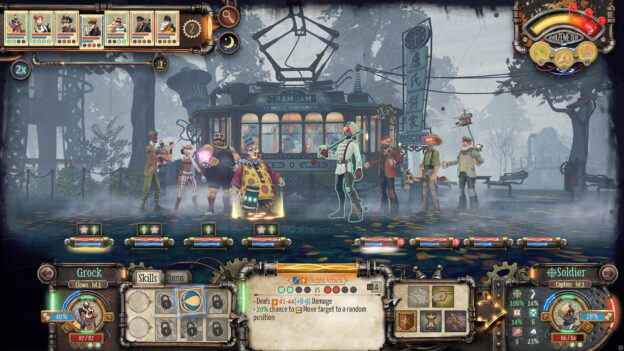I’ve played many different RPGs in over 40 years of gaming. I’m a huge fan of the genre and thought I’d seen it all. That was until I played Circus Electrique, a game with an intriguing story, steampunk artwork, and incredible voice acting. Did I mention that circus performers make up your team? It doesn’t always get to all sides, but it’s an interesting concept and the story drives the game.
The story takes place in London in the late 1880s and follows a newspaper reporter named Amelia. She’s investigating something known as Madness, where the people of London are attacking each other.Amelia’s backstory is fascinating. Her mother was a circus performer who died in a horrific accident ten years before the current events of the game, and the circus was closed. However, her uncle, who is a ringmaster, recently revived the show. Amelia does not trust her uncle and she suspects that her uncle is somehow involved in recent events. He insists she take a group of performers with her as she delves into her story. The entire game is voice-acted and the acting is well done.
Another strength is the artwork. The game takes place in Victorian London, so the mix of background his scenes and steampunk vibes is vibrant and visually appealing. In addition, the circus performers on your team, especially the clowns, are charming and spooky looking. Indeed, they look more menacing than their opponents.

There is a lot going on in this game. There are tutorials, but a welcome codex is available and accessible when you have questions. A unique aspect in combat is Devotion, another meter that determines a character’s success. The higher your dedication, the more damage you can do. Various skills also affect this stat. For example, my clown can cheer up my party and increase the dedication of the whole team.
Another feature is the Amazemeter, which is unlocked only after defeating the first boss. Using your character’s skills fills the gauge, allowing you to perform powerful attacks and recovery. You can upgrade your amaze meter and experiment with putting abilities in different slots.

Gameplay combines both turn-based battles and circus management. On the administrative side, we draft performers and place them in shows. Every gig has different slots with preferred performance types. Each team his member has a card that shows his best placement in production and a chemistry icon that shows who he works best with. The higher the chemistry, the better the results, meeting or exceeding audience expectations.

There are a few things that keep the game from sticking to landing. The circus is well run, but interrupts the flow of the whole game. After each battle, another show should be set up. Therefore, I was often drawn out even though I just wanted to advance the story.
Another drawback is that the print and icons for each character are small and difficult to see in handheld mode. However, these criticisms did not detract from the overall enjoyment of the game.

